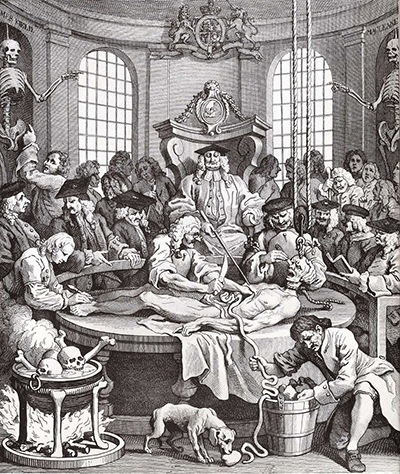The Reward of Cruelty is a piece by William Hogarth that was created in 1751. It is part of a four-piece collection by Hogarth called the Four Stages of Cruelty.
The Reward of Cruelty is the last of the stages. From its name, one can already tell that the subject of the piece must be someone reaping the fruits of their cruelty. This person is Tom Nero.
This engraving is an unforgettable piece that depicts Tom Nero's body on a platform in the Royal College of Surgeons. This dramatic scene shows the final stages of Tom Nero’s body after his conviction and execution. He ends up in a lab with surgeons who appear to be taking pleasure in their dissections just like the boys relished their tortures in his first composition called the First Stage of Cruelty. Tom Nero’s head is screwed to an abnormally tall crane. There is a doctor in the scene, who is gouging Nero’s eye. This act is also similar to William Hogarth’s first piece where the boys torture a bird.
Below the platform, in the foreground, there is a dog which appears to be eating Nero’s heart. The artist used this to symbolize the revenge on his cruelty to animals when Nero was a boy. The scene in question is the Cutlerian theatre which is at the Royal College of Physicians. Other than the main message of the composition, there is the chief surgeon at the centre seated on an elevated chair. On either side of the composition, there are skeletons under the labels ‘MACLEANE’ and ‘GENTN: HARRY’, who were criminals that were recently hanged.
This art piece is categorized as a print and the medium used by the artist was etching and engraving. Its original dimensions are 14 7/8 x 12 1/2 in. (37.8 x 31.8 cm). The original engraving and etching were first printed on a 19th century wove paper. It was first published by William Health himself and it had large margins. This print, together with the other three prints that completed the four stages, was designed with the intention of 'preventing cruel treatment of poor animals in the streets of London'. In the prints, he also features the life of Tom Nero, a child from the slums, that begins to torture dogs and his behaviour progresses to beating horses in the streets of London. He then murders his pregnant lover, Ann Gill, when he is grown up. Tom is then prosecuted and hanged.




